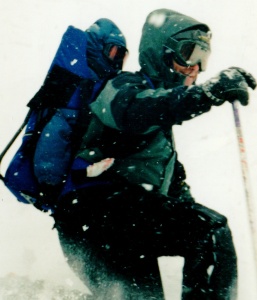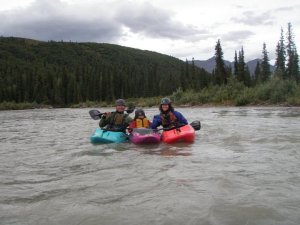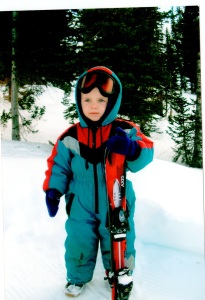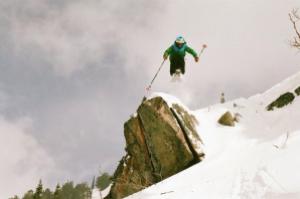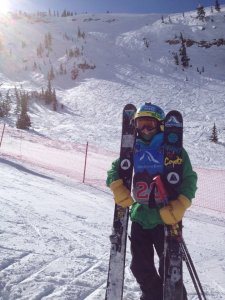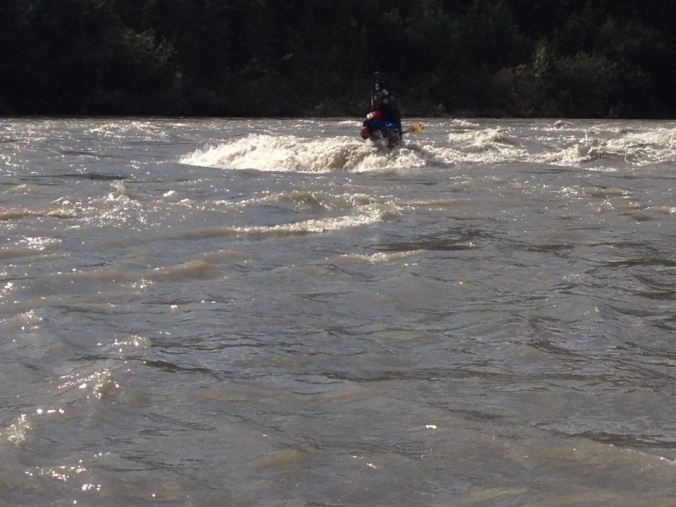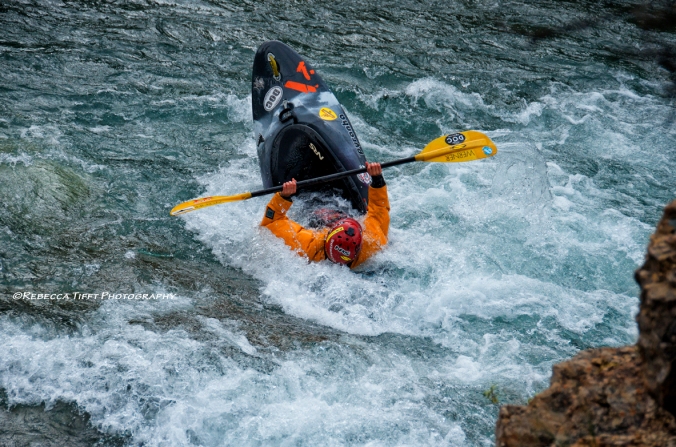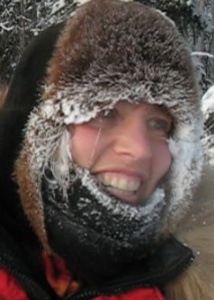
A frosty Aliy Zirkle
For those willing to break the paradigm, a deeper fulfillment becomes possible. In the dog mushing community, Aliy Zirkle represents a breed of mushers who learned to travel with dogs by following their passion for adventure. Initially, Aliy had no intention of racing, let alone making a living off of it. Now, after three consecutive second place finishes in the thousand-mile Iditarod Sled Dog Race, Aliy has unquestionably developed into the people’s favorite competitor in this year’s race. It’s easy to look back at her life now and see destiny, but the true story shows a trail of blood, sweat, and passion.
One flyer on a University of Pennsylvania lab door rerouted sophomore biology student Aliy Zirkle’s future. “Why are you studying biology in downtown Philadelphia when you could be in Alaska?” it asked. Aliy wondered the same thing and seized the bait. She volunteered for Fish and Game in a national wildlife refuge on the Alaska Peninsula, made $4 a day, and fell for Alaska, “hook, line, and sinker.”
Two years invested in college obliged Aliy to finish her degree. Traditional life, after all, was the culture she knew and the environment college propelled her toward. She contemplated med school versus vet school, but the standard path felt lackluster compared to the connection she felt to summers in Alaska. The post-college rhetoric soon changed to finding a “real job” in Alaska. After graduation she wrote 250 letters to parks, BLM, and everything in between; received two offers, and selected the more remote location of Bettles, Alaska.
The formative years
Nicknamed “Gateway to Arctic National Wildlife Refuge,” Bettles lies above the Arctic Circle, has a winter population of 35, and is disconnected from the road system. Therefore, the village is accessible only by airplane, boat, snow machine, or dog team, depending on the time of year. Dog mushing captivated Aliy immediately but she knew nothing about it. She bought one dog and a random book on the subject written by a woman “who’s probably from Wisconsin,” and started figuring it out. At the time, she didn’t know people bought dogs from champion kennels for several thousand dollars and it wouldn’t have mattered if she did—this wasn’t about competition but traveling the land and learning self-sufficiency.
Initially, she brought her dog, Skunk, to the other two kennels in the village and asked to run her dog with theirs. However, she soon realized “that probably wasn’t really correct” so she adopted five more dogs. Guided by her mushing book, she built a sled, figured out harnesses and lines, and began traveling with her hodgepodge team.

Purely Alaskan
In the early days, twelve miles was a big adventure. She’d set up a camp with a tarp and cook dog water over a fire. “That was really cool to me, being totally self-contained with no mechanical anything—fire, dogs, snowshoes, and go.” Eventually, someone invited her on a fifty mile trip—an intimidating prospect. “I was like, ‘are you serious? I don’t think I could do fifty miles. I could do it but it would take me, like, a week.’” Yet soon she was exploring the Brooks Range on more robust trips with friends who opened her eyes to what dogs were capable of accomplishing. They traveled forgotten trails and seldom saw another soul. “There’s not a lot of people in that part of Alaska in the winter. No one goes snowmachining for fun there.” She stayed in Bethel four years and never stopped learning. “You can do so much more with dogs because they have the power to help you carry stuff and go for a long ways. One soul being out there is a lot harder and scarier and wild than with a group of dogs. They’re there to help you.” Little did she know, she had only scratched the surface of what dogs are capable of athletically.
Transformation

SP Kennel out on the trail
Dogs became Aliy’s passion. When a busy friend near Fairbanks needed help with his kennel, she seized the opportunity to work with larger dog teams and moved back to the road system. The following winter she handled for her friend on the Yukon Quest—a thousand mile sled dog race that alternates direction between Fairbanks and Whitehorse in the Yukon Territory. This introduction to long-distance racing inspired her to run it herself and the following year Aliy came in 17th out of 26.
Halfway through the race, Aliy left Dawson near the back of the pack and hit a blizzard around American Summit. Another musher, heading east on a westward racecourse advised Aliy to follow suit. Aliy was incredulous. “I was like, ‘Turn around? Where are you going? Dawson is, like, 75 miles. I’ll stop and camp for awhile but I’m not going to turn around.’” She continued on and never saw another dog team for 450 miles. “All the teams who were ahead of me were so far ahead of me that when I came into a checkpoint they’d already left and all the teams that were behind me had waited for that storm so my first thousand mile race, for 500 miles I didn’t even know I was racing because I was just the only one there.” It didn’t matter.
Fairbanks was practically home, so it never occurred to her to quit the trail. She had to get to that area eventually—it may as well be by dog team. “I came to the finish line, the banquet had started two hours earlier, and I remember the Yukon Quest champion in 1998, Bruce Lee, saying to me, ‘Aliy, they get easier after the first one.’ They did. He was right—until last year.”
When Aliy initially moved to the Fairbanks area she still had a job with Fish and Wildlife as a biological technician making decent money. For many people with her background, she’d found the ultimate career track that synthesized the love of the outdoors with a steady paycheck. “I could have definitely done that for twenty years and then been free with my retirement.” She recalls the incessant buzz of artificial lights in February while people sat around making work for themselves. Discontent and disconnected from her reasons for being in Alaska, dogs pulled her toward something richer.
When Aliy chose to leave her Fish and Wildlife job to bartend, work construction and pursue dogs she officially left behind the academic pathway for the passionate one. Since then, the girl who was once intimidated by fifty miles has finished seventeen thousand-mile races, won the Yukon Quest in 2000 (two years after her rookie race) and took second in the Iditarod the last three years. Aliy found her passion, lives it daily, and has taken it to a competitive and economically viable level.
Commitment
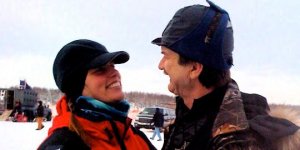
Aliy and Allen
Aliy’s entire world revolves around the kennel she operates with her husband, Allen Moore. Although the travel-for-fun harnesses are hung up, long-distance racing continues to deepen that connection. “Both Allen and I have always had a competitive spirit. If you’re going to do something, you’re going to do it to the best you can do.” SP Kennel requires complete devotion from both of them these days. “We are similar yet we are different enough that we can have a work relationship and a love relationship.” Their differences become complimentary strengths in keeping their kennel sharply competitive. That relationship, the commitment to the dogs and to each other, is a driving force in their success. “I love him with all my heart. I would do anything for him, but he probably wouldn’t ask me to do everything for him. But I would.”
At SP Kennel, the dogs and mushers work equally hard. “Our dogs enjoy themselves but they’re working dogs. They have this desire to work that comes from being raised by us.” To be at the top, everyone must give their best everyday. “You’re going to fail sometimes and you’re going to make the wrong decisions sometimes, and that’s all okay as long as you always continue to know that you always tried your hardest.” Aliy and Allen raise all their dogs at their kennel and only breed one litter a year.
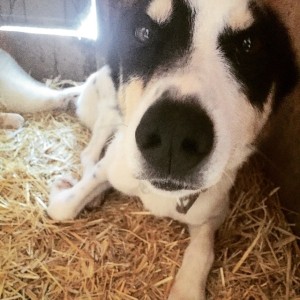
Schmoe helped lead Allen’s team to second place in the Yukon Quest earlier this month
“You put a hell of a lot of effort into them. You know them, you know their parents, you know their grandparents, you know that when Scooby fell in the water when he was 7 weeks old that’s why he’s scared of water. You just know everyone and that’s what almost makes it not only addictive but more competitive, as we continue to raise these dogs they get better and better and better because we only breed the best physically and mentally to the best physically and mentally. Year after year, we’re like holy cow, they not only keep getting better genetically but they’re more part of us.”
Last year’s race surpassed ’98 as Aliy’s most challenging race, yet she finished only two and a half minutes behind the champion, Dallas Seavey. Low snow conditions and a game-changing windstorm near the finish meant the 2014 Iditarod required a bit of luck for even the most savvy race veterans. “That just makes fuel for the fire when you get through an incredibly hard situation and you’re actually still alive.” Aliy asks one hundred percent of her dogs in all conditions and in return she can’t give anythings less. Dogs are acutely attuned into their musher’s psychology, so when the trail is toughest Aliy must reach inside herself for something positive to give back to them. “If I was down either physically or mentally, I would be the one letting the whole team down.” Intense sleep deprivation preys on mental weakness and therefore the musher is simultaneously the leader and the weakest link. The harder it gets, the more Aliy strives to rise to the challenge and prove to herself that she can handle it. “Last year’s Iditarod did nothing but get me more and more positive about my dogs’ ability, my ability, and our commitment to each other.” More than anything, chasing a win is about giving the dogs the recognition they deserve.
Purity of the Race
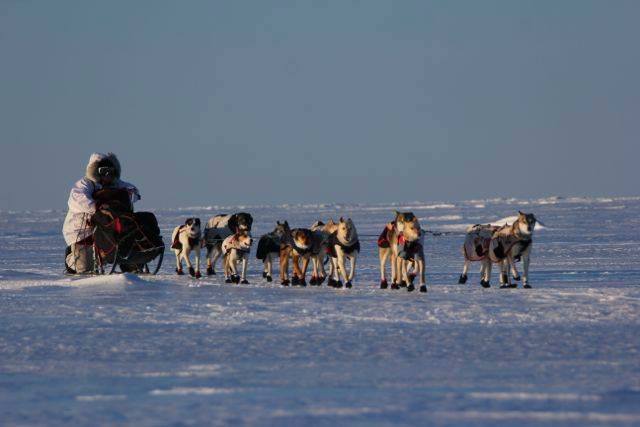
Aliy and the team out on the Bering Sea ice, Iditarod 2014 (photo courtesy of Sebastian Schnuelle)
Aliy represents a breed of mushers who learned the land, and learned to travel with dogs for the sheer passion of it, without intention to race. As the Iditarod becomes a bucket list item for wanna-be wilderness types, Aliy recognizes that less-skilled people are going to be scraping together the minimum requirements to participate in the race. While that weakness is unavoidable, there is something else compromising the race even further: the rescue button.
When activated, the SPOT rescue button sends GPS coordinates to a designated center to summon help. “The button,” Aliy sighs. “I’m not a fan of the button, personally.” After examining her background it’s easy to understand why. “So, when I first started mushing I had those six dogs, it was me, myself and I, and six dogs. I learned right away that I had to stay with them and they had to stay with me, so I started wearing a leash on my arm. Wherever they went I went, wherever I went they went. It’s a team, it’s a commitment; it’s everything. So I’m not into the button. Every one of those people could have just taken a breather, you know, fed their dogs for 24, 26, 48, 50 hours, a week, and then gotten somewhere. Just because your race is over doesn’t mean you have to push the button, to me.”
The purity of the race lies in self-sufficiency which the rescue button undermines. “The glamor of the race really was you and your team endure what you need to endure to get where you need to get, but that goes back to these people who are just there to race it.” There’s no going back once you soften the race. She continues, “These people need to read some books of, like, 150 years ago where, like, Russian sailors were stuck above Svalbarg in Norway and, like, endured three months of hiking across open sheets of ice. We need to be that way if you’re claiming to be this long-distance, endurance musher.” Furthermore, those who don’t raise their own dogs or embed in that lifestyle never develop a spiritual connection with the landscape—a journey that only increases the reward. When sled dog racing is approached and treated like a Nascar race, some mechanical thing on a track, that organic connection is lost.
Failures and successes in equipment, dog training, and handling personal emotions—as well as the ability to prioritize all of the above in extreme conditions—is what grooms the musher. Alaska reality television perpetuates a myth that Alaskans take extreme risks and live in constant danger. Similarly, Into the Wild glorifies a kid who cut human ties and common sense from his life and died attempting to live off a foreign landscape. True Alaskan wilderness men and women, however, learn to listen to the nuances of the environment to mitigate risk. Native cultures have always done this. As that way of life is continually compromised, Iditarod pays homage to that lifestyle by celebrating sled dogs’ value in the landscape. If the race’s spirit lies in the relationship to the land and the ability to care for and depend only on your team, then the rescue button mocks that intent and simultaneously puts local volunteers in adverse conditions on behalf of the poorly prepared. This is a nine-day race not a four-hour game. There is no rescue button in Alaskan bush life.
Inspiring passion
Aliy felt uninspired by the 9-5 dream so she invented her own. “That was always so very run of the mill. You can live life easily these days as an American or some other country, get a little job, make enough money to have a small place to live, eat, buy food at Wal-Mart—you can live, it’s not hard to live.” To strive for something outside the paradigm, however, takes courage, but with that comes potential for incredible reward. Guided only by passion, Aliy bushwacked an unmapped path toward personal fulfillment.
Most people get into dog mushing through dog handling for a professional kennel but Aliy modeled a different method. “It’s an obvious way to get into it, but crap, you could go get a job anywhere in Alaska and make a little bit of money and have six dogs and be pretty righteous and go to Hatcher Pass. I never had a dog truck in the beginning, I had a little Chevy S10 and all the dogs fit in the back.” If the passion is to travel the land by dog team, then pursue that because competition morphs the training philosophy and reduces raw adventure overall.
At the professional level, dogs require far more invested time and energy than the 9-5. “I can’t imagine how many hours a week I put into my, quote, job now so 40 hours a week is like a pittance.” However, every iota of that time and energy is invested in personal fulfillment. Aliy encourages kids who are uninspired by traditional culture to shed their fear of adults disagreeing with them, and instead listen to their passions. “Realize that there are different ways to please people. You can please family, friends, and yourself through so many different means than your normal societal expectations.” By relaxing our clutch on tradition we can more fully embrace our personal values. “I definitely think you can break the mold if it’s a passion,” Aliy encourages.
Aliy made a conscious decision to pursue this lifestyle; it wasn’t an accident. “I still think that the bottom line to life and to mushing and to dogs is that you have to actually enjoy your life because your life could end tomorrow. These dogs know that they’re going to have fun.” Fulfillment comes not from money but from the bond with the dogs. The lifestyle is the reward. Professional Nomads are nomads by choice, not by default. “Find your passions. I’m excited to have found my passion and not everyone does.”

Aliy out on the Bering Sea ice, Iditarod 2014 (photo courtesy of Sebastian Schnuelle)
Learn more about how you can become a dog musher from our Skill Building Resource Page
Want more from Aliy Zirkle? Become an Insider and follow Aliy in the Iditarod! Race begins March 7th!
Want more from Professional Nomads? Click “follow” below and like us on Facebook!












